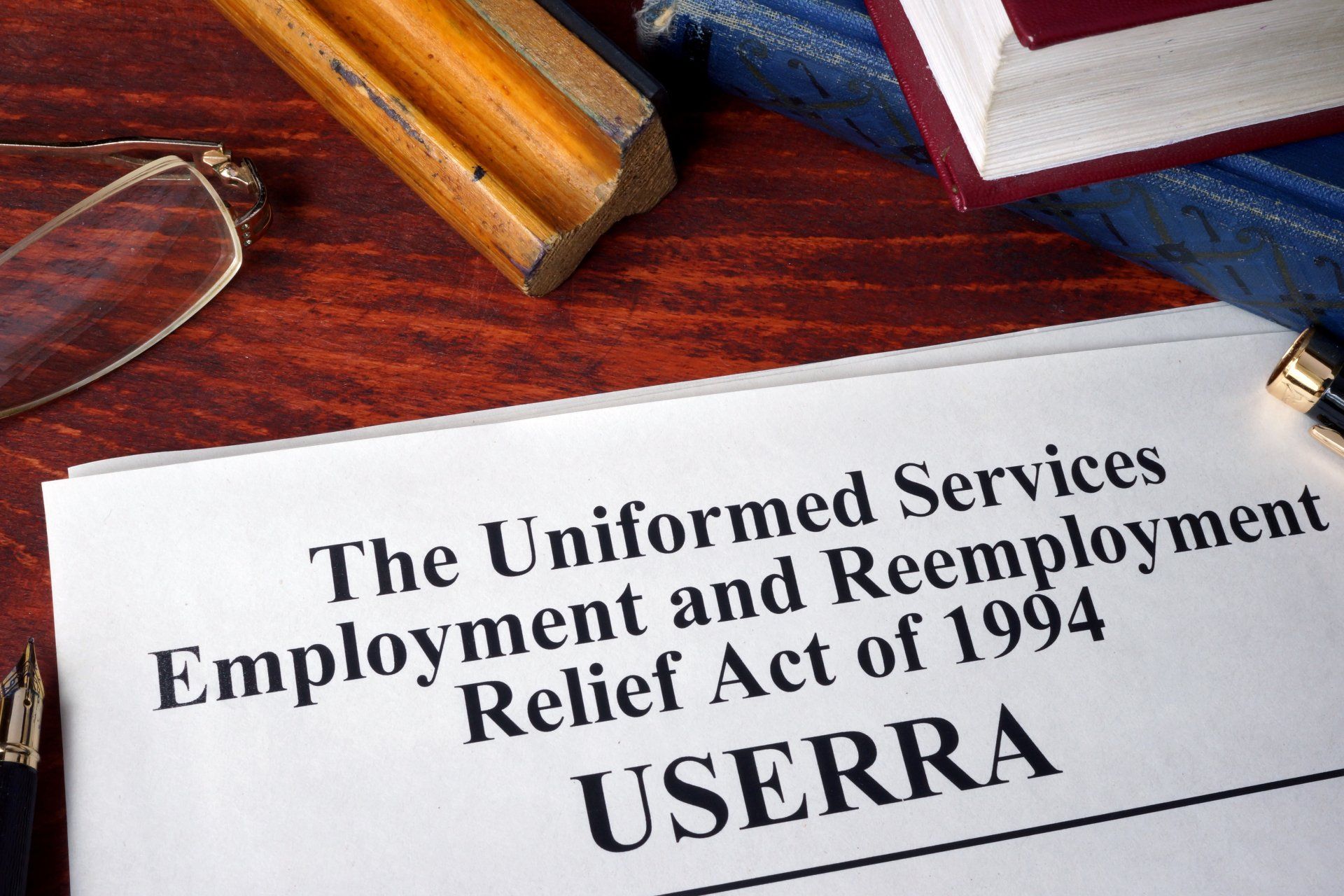
USERRA Requirements for Benefits – FAQs
8 November 2022

The Uniformed Services Employment Reemployment Act (USERRA) provides civilian employment protections for employees’ who are part of Military Service. The Act outlines the requirements of employers and employees. The Employer Support of the Guard and Reserve (ESRG) and the Department of Labor (DOL) aim to clarify the details of the Act for those covered by it through resources and frequently asked questions (FAQs).
Here are some of the most frequently asked questions about USERRA to help employers and employees better understand their rights and obligations according to the Act.
What Employers are Covered by USERRA?
USERRA applies to:
• Government, Private, and Public employers in the U.S.
• Foreign employers doing business in the U.S.
• U.S. and American entities operating in foreign countries, unless the laws of the foreign county would be violated due to USERRA compliance
What Military Service Types Does USERRA Cover?
Most often, USERRA is understood to apply to Guard and Reserve military personnel only. However, “service in the uniformed Services” according to USERRA’s definition coverall all categories of military service and training. Duty performed on an involuntary or voluntary basis in times of war or peace is also included.
USERRA applies to those serving in the active components of the National Disaster Medical System, Armed Forces, and the Commissioned Corps of Public Health Service along with Reserve and Guard military personnel.
Does USERRA Protect Federal Employees?
Yes. Under USERRA, non-Federal employees and Federal employees have the same rights and responsibilities.
The Department of Labor Veteran’s Employment and Training Service (DOL VETS) or ESGR are both options through which Federal employees can seek assistance. DOL VETS can refer cases to the Merit Systems Protection Board or Office of Special Counsel when appropriate.
Can Employers Discriminate Based on Present or Past Service in the Military?
No, employers cannot discriminate based on present or past military service. An employer cannot deny promotion, retention in employment, initial employment, reemployment, or any employment benefit based on a person’s military service. Also, an employer must not retaliate against an employee by employing any adverse action of employment because the employee:
• Has enforced protection afforded to anyone under USERRA
• Participated or assisted in a USERRA investigation
• Made a statement or testified in or in connection with a proceeding under USERRA
• Exercised a right provided for by USERRA
Does USERRA Provide Protection Against Initial Hiring Discrimination?
Yes, it does. Under USERRA, an employer does not actually need to employ an individual to meet the definition of “employer.” If a person, organization, institution, or other entity has denied initial employment based on the person’s military status of any sort, including affiliation application for membership, application for service, the obligation for service, or performance of service in the uniformed Services.
For example, if someone has obligations as a member of the Reserve or Guard and is denied initial employment as a result of those obligations, the entity denying employment is an employer as defined by USERRA. Likewise, if an employment offer is withdrawn because of one being called upon to fulfill a uniformed Services obligation, the employer withdrawing the offer is defined as an employer under USERRA.
Is There any Particular Form Requirement for Reemployment?
There is not any particular format to apply for reemployment. The returning employee can apply in writing or verbally to the pre-service employer or to a representative or agent of the entity who is the point of contact to receive employment applications.
Regardless of the form, the application should indicate that the employee is returning from the uniformed Services and that they seek reemployment with the pre-service employer. The employee can indicate the position of interest, though it is not required.
Is the employee required to provide reemployment application documentation?
Yes, if they are asked to do so by their employee and their Service is 31 or more days. The documentation must show that:
• The application for reemployment is timely
• The dismissal or separation from service was not disqualifying
• The total duration of service time limit of five years has not been exceeded
What are the USERRA Guidelines for Employees to Return to Work Following Military Service Completion?
The Service member is required to apply for reemployment or report back to work within the following guidelines or risk being ineligible for protection under USERRA:
• 1 to 30 days of service: Report next scheduled work day after safe travel and 8 hours of rest
• 31 to 180 days of service: Apply within 14 days after completion of service
• 181+ days of service: Apply within 90 days after completion of service
Is the Employee Protected From Discharge Under USERRA?
Yes. Unless for cause, an employee with military service of 30 days or more cannot be discharged for:
• One year after the date of reemployment if the employee’s most recent period of uniformed service was greater than 180 days.
• 180 days following the employee’s reemployment date if his or her most recent period of uniformed service was over 30 days but less than 181 days.
To be Eligible for Reemployment After Military Service, What criteria Does the Employee Need to Meet?
An employee will be eligible for reemployment under USERRA after being absent from a position of civilian employment if they meet the following criteria:
• The employee provided advance notice to the employer of the employee’s military obligation
• The employee has been away from the employer for five years or less because of military obligations (excluding exemptions)
• The employee return to work in a timely manner as defined by USERRA
• The employee hasn’t been separated from the uniformed Services with a disqualifying discharge or under other than honorable conditions.
Can Entities Contact One’s Military Chain of Command to Verify Military Service?
Yes, they can. According to USERRA, Service members only have to provide proof of uniformed service if it is 31 days or more and the employer requests it. However, employers may contact the employee’s military chain of command to request verification, and per Department of Defense Instruction 1205.12, the Military Departments are required to verify periods of uniformed service upon an employer's request, regardless of the length of the service-related absence.
Service members' uniformed service information permitted to be released to third parties is highlighted in DoD 5400.11-R, Department of Defense Privacy Program, May 14, 2007. In section C4.2.2.5.2.. the following are described as routine use disclosures specific to military members (see DoD 5400.11-R for a complete list):
• C4.2.2.5.2.1.1. Full name.
• C4.2.2.5.2.1.5. Past duty assignments.
• C4.2.2.5.2.1.6. Present duty assignments.
• C4.2.2.5.2.1.7. Future assignments that are officially established.
• C4.2.2.5.2.1.13. Duty status at any given time.
To review DOD 5400.11-R. Department of Defense Privacy Program, click here.
After More Than 30 Days of Service, What Documents Satisfy the Requirement That the Employee Establishes Reemployment Eligibility?
Documents that satisfy the requirements of USERRA include any of the following:
• Discharge certificate showing character of service
• Copy of duty orders prepared by the facility where the orders were fulfilled and carrying an endorsement indicating completion of the described service
• Certificate of completion from military training school
• DD214 - Certificate of Release or Discharge from Active Duty
• Copy of extracts from payroll documents showing periods of service.
• Letter from the commanding officer of a Personnel Support Activity or someone of comparable authority
Documents required will vary between cases. Not all the listed documents are necessary or available in every instance.
Under USERRA, What Types of Separation or Discharge From Uniformed Service Make an Employee Ineligible for Reemployment Rights?
Termination of reemployment rights occurs if the employee is:
• Separated for bad conduct or dishonorable discharge
• A commissioned officer dismissed in commutation of a sentence of a general court-martial, by sentence of a general court-martial, or, in time of war, by order of the President
• Separated under other than honorable conditions, as characterized by uniformed Service regulations
• A commissioned officer dropped from the rolls due to a sentence to confinement in a Federal or state penitentiary or correctional institution, absence without authority for at least three months, or separation by reason of a sentence to confinement adjudged by a court-martial
Does the Employee Need to get Permission From an Employer Prior to Leaving for Military Service?
No. The only requirement is for the employee to give the employer notice of pending service.
Does an Employee Have any Seniority Rights When Reemployed Following Military Service?
Employees are entitled to seniority-based benefits and rights they had at the time military service began. In addition, they have access to seniority-based benefits and rights they would have achieved if they were continuously employed. In addition, status and rate of pay are treated similarly.
By When is a Civilian Employer Required to Reemploy the Employee?
Prompt reemployment as soon as practical on a case-by-case basis is required when the employee returns from Service and meets USERRA’s eligibility criteria. Outside of unusual circumstances, within two weeks of the employee’s reemployment application is when reemployment must occur. In cases where several years of active duty have passed, more time might be required to reassign or place the returning employee.
Does the Employee’s Level Within the Organization Impact Their USERRA Eligibility?
No. All employees at all levels, including professional, managerial, and executive levels, are covered under USERRA.
Are Independent Contractors Covered Under USERRA?
No. Independent contractors are not covered under USERRA.
Does the Employee Need to Give Notice in Advance to Their Employer for Military Service Leave?
Yes. An appropriate officer of the uniformed Service or the employee must give notice to all of the employee’s employers, if they have more than one, of the upcoming military service leave. The notice can be in writing or verbal. Though there isn’t a set rule, it’s recommended that the employee give as much notice as possible.
Does the Employee Need to Inform Their Employer of Their Desire for Reemployment Upon Military Service Completion?
Employees do not need to decide in advance and do not forfeit their right to reemployment, even if they state they don’t plan to pursue reemployment prior to their Military Service.
Is There a Service Accumulation Limit in the Uniformed Service for an Employee to Retain Reemployment Rights?
Yes. A cumulation of up to five years is permitted, in general, and under the current statute, for the employee and they still retain reemployment rights.
What are the Exceptions to the Five-Year Service Accumulation Limit Under USERRA?
The Department of Labor highlights these eight categories of service as exempt from the five-year limitation:
1. Service required beyond five years to complete an initial period of obligated service – Section 4312 (c) (1). Some military specialties, such as the Navy’s nuclear power program, require initial active service obligations beyond five years.
2. Service from which a person, through no fault of the person, is unable to obtain a release within the five-year limit – Section 4312 (c) (2). For example, the five-year limit will not be applied to members of the Navy or Marine Corps whose obligated service dates expire while they are at sea. Nor will it be applied when service members are involuntarily retained on active duty beyond the expiration of their obligated service date.
3. Required training for Reservists and National Guard members – Section 4312 (c) (3). The two-week annual training sessions and monthly weekend drills mandated by statute for Reservists and National Guard members are not counted toward the five-year limitation. Also excluded are additional training requirements certified in writing by the Secretary of the service concerned to be necessary for individual professional development.
4. Ordered to involuntary service, or retained on active duty during domestic emergency or national security-related situations – Section 4312 (c) (4) (A).
5. Ordered to service, or to remain on active duty (other than for training) because of a war or national emergency declared by the President or Congress – Section 4312 (c) (4) (B). This category includes service not only by persons ordered to involuntary active duty, but also service by volunteers who receive orders to active duty.
6. Active duty (other than for training) by volunteers supporting “operational missions” for which Selected Reservists have been ordered to active duty without their consent – Section 4312 (c) (4) (C). Such operational missions involve circumstances other than war or national emergency for which, under presidential authorization, members of the Selected Reserve may be involuntarily ordered to active duty under Title 10, U.S.C. Section 12304. This sixth exemption for the five-year limitation covers persons who are called to active duty after volunteering to support operational missions. Persons ordered to involuntary active duty for operational missions would be covered by the fourth exemption.
7. Service by members who are ordered to active duty in support of a “critical mission or requirement” of the uniformed services as determined by the Secretary involved – Section 4312 (c) (4) (D).
8. Federal service by members of the National Guard called into action by the President to suppress an insurrection, repel an invasion, or to execute the laws of the United States – Section 4312 (c) (4) (E).
Does the Employee Need to pay for the Continuation of Health Coverage?
If performing service for less than 31 days, employees cannot be made pay greater than the employee’s regular share. If service goes beyond 31 days, the employee cannot be required to pay more than 102% of the full premium, representing both the employee’s and employer’s share in addition to 2% for administrative costs. It is up to the employer to determine how the employee will pay for continuing coverage.



